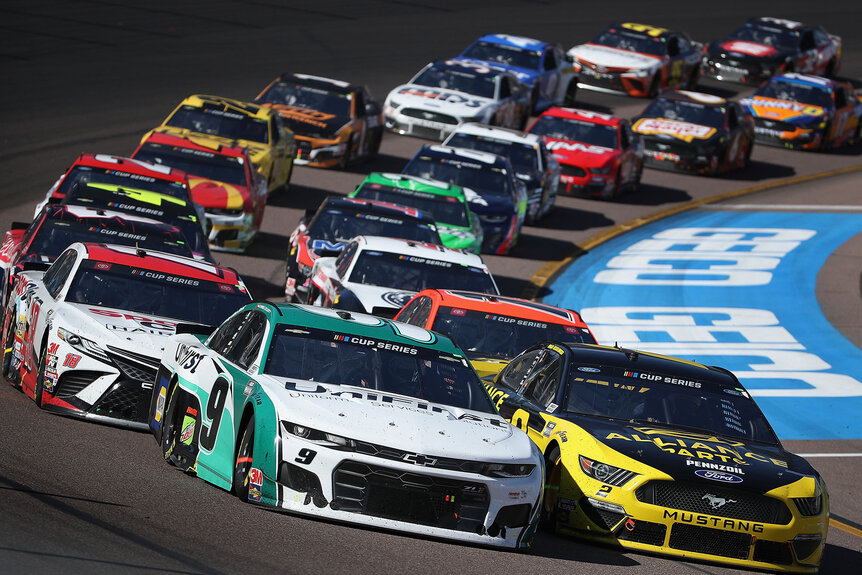Create a free profile to get unlimited access to exclusive show news, updates, and more!
How Do The NASCAR Cup Series Playoffs Work?
Sixteen of NASCAR's biggest stars, like Kyle Larson and Chase Elliot, will be competing for the coveted Bill France Cup. Here's what to expect as the playoffs unfold.

It’s playoff season, baby.
The postseason marks the beginning of the best part of any sports – the quest toward the championship. It’s absolutely the most exciting time to be a fan watching along at home (or in person), and the time is now for NASCAR, as its Cup Series playoff is about to kick off in a big way.
While the NASCAR Cup Series playoff features 16 participants, similar to how sports like the NBA and NHL operate their postseason, racing’s biggest championship chase is a little different as a traditional bracket isn’t utilized to crown the champion.
Let’s break down exactly how the NASCAR Cup Series playoff system operates. This is a great chance for a quick refresher – or if you’re a new fan to the sport, it’s a great primer to better understand the exciting races that you’ll be watching over upcoming weeks and months.
How Drivers Qualify For the Playoffs
Only the best of the best can compete for the championship, and NASCAR is no different. The championship bracket is set up for 16 competitors. The easiest (or hardest, depending on your point of view) way to qualify for the postseason was to win a regular-season race.
Fifteen different drivers won races during the 26-race regular season – each driver secured a spot in the playoffs with those wins. Many drivers won more than one race – but more on that in a moment.
The 16th and final driver was awarded a spot in the playoffs by virtue of having the most “playoff points.” Which brings us to our next question.
What Are Playoff Points?
During the regular season, drivers can earn points. Here’s the breakdown:
- Winning a race: 5 points
- Winning a stage: 1
- Regular season champion: 15
- Second-place regular season: 10
- Third-place regular season: 8
(And so on, with diminishing point values for each placement.)
In addition, bonus points can be earned during the regular season by reaching various goals, such as leading for a certain amount of laps in a particular race. Also, 2,000 points are added to each driver’s total once they reach the playoffs.
In the case of this year’s playoffs, Ryan Blaney is the only driver participating in the quest for the Bill France Cup who didn’t actually win a race – but due to the amount of playoff points he amassed, he got in.
Chase Elliott, the overall #1 seed, earned the top spot by winning four races during the regular season.
Here’s the official list of all the drivers competing in the NASCAR Cup Series playoffs:
- #9 - Chase Elliott, 2040 points
- #22 - Joey Logano, 2025 points
- #1 - Ross Chastain, 2020 points
- #5 - Kyle Larson, 2019 points
- #24 - William Byron, 2014 points
- #11 - Denny Hamlin, 2013 points
- #12 - Ryan Blaney, 2013 points
- #8 - Tyler Reddick, 2012 points
- #4 - Kevin Harvick, 2012 points
- #20 - Christopher Bell, 2011 points
- #18 - Kyle Busch, 2010 points
- #14 - Chase Briscoe, 2009 points
- #99 - Daniel Suarez, 2007 points
- #2 - Austin Cindric, 2006 points
- #48 - Alex Bowman, 2006 points
- #3 - Austin Dillon, 2005 points
The Playoff Format
There are four different rounds of the playoffs.
It begins with the Round of 16, featuring the drivers listed above. The NASCAR Cup Series playoffs then shifts to the Round of 12, followed by the Round of 8 – finally culminating with the final round, the aptly named Championship 4. (Check out the full NASCAR playoff race schedule, including how to watch, here.)
Each round will consist of three races, with the exception of the Championship 4, which will be only one race – ensuring ultra-high stakes for the finale.
How the Postseason Progresses
So with four drivers eliminated from title contention after each round, how exactly can drivers advance in the playoffs? It’s simple, really. Drivers can advance by one of two ways:
Winning a race automatically pushes them into the next round.
In lieu of winning, drivers can also advance into the next round via points – having enough points above the cut-off elimination line, to be more specific. Whether it’s from winning stages or accruing bonus points or simply finishing high, it’s straightforward: advancing to the next round is directly correlated to each driver’s performance.
For example, if a driver finds himself in 13th place in the standings after the Round of 16, we have bad news: that driver is officially eliminated from the playoffs.
Points are tallied continuously throughout the playoffs and through each round – this ensures that regular season performance isn’t thrown out the window, and one average finish in the playoffs doesn’t necessarily spell doom for that driver in the playoffs.
At the end, it all culminates with the Championship 4 at Phoenix Speedway with the final four contenders for the NASCAR Cup Series Championship.
It’s important to note that for the final race, all points accrued by each driver is irrelevant, effectively making the Championship 4 a pure one-race finale to crown 2022’s champion. This guarantees heart-stopping drama and frenetic action for NASCAR’s final race of the season – the ultimate treat for fans of the sport around the world.
Now that you’ve had your primer on the ins and outs of the NASCAR Cup Series playoffs, you’re ready to sit back and take in the highest-octane playoffs in all of sports!
The playoffs officially kick off this Sunday, Sept. 4 with the Southern 500 from Darlington Raceway. Catch it live on USA Network at 6 pm ET!
Can't get enough NASCAR action? Watch “Race For The Championship,” which follows the lives of NASCAR's biggest stars on and off the track, premiering on Sept. 1 on USA Network at 10 p.m. ET. And catch up on all race action on Peacock.
















